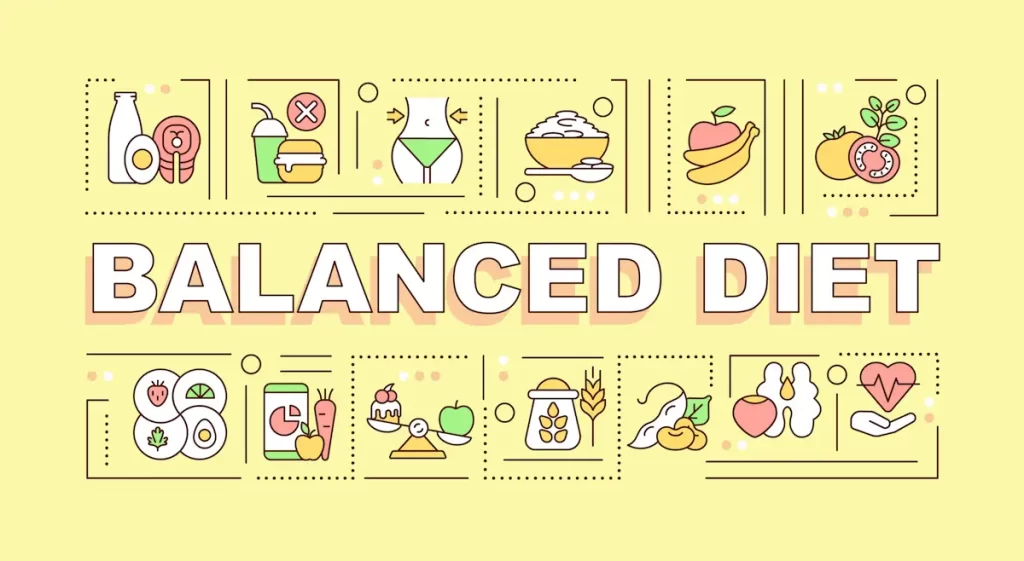Eating healthy can feel confusing with so many food choices. A balanced diet gives your body essential nutrients to stay strong and energized. This guide will include simple steps to create a healthy, balanced diet.
Thank you for reading this post, don't forget to subscribe!Keep reading—you’ll find easy tips to improve your meals!
Key Takeaways
- Fill half your plate with fruits and vegetables daily. Aim for five portions of about 80 grams each. Limit juices and smoothies to 150ml a day.
- At least 50% of grains consumed should be whole grains like brown rice, quinoa, or oatmeal to improve digestion and lower cholesterol.
- Include two servings of fish weekly, one being oily fish like salmon for heart health. Combine animal and plant proteins like eggs, beans, or tofu for balance.
- Reduce added sugars, saturated fats (red meat), and sodium by choosing fresh foods over processed ones to avoid high blood pressure or heart disease risks.
- Stay hydrated with 6–8 glasses of water daily. Add fruits or herbs for flavor instead of sugary drinks to support energy levels and wellness.
Key Components of a Balanced Diet
Eating a balanced diet means choosing foods that nourish your body and meet its needs. Each food group plays a role in giving you energy, vitamins, and nutrients for good health.
Fruits and Vegetables
Fruits and vegetables should fill at least half your plate. Experts recommend five portions daily—about 80 grams each for fresh, canned, or frozen types. Dried options count too but stick to 30 grams per day.
Juices and smoothies fit the list but limit them to 150ml since they lack dietary fiber. These foods are high in vitamins, minerals, and antioxidants, lowering heart disease risk and protecting from certain cancers.
Dark leafy greens like spinach, kale, and collard greens pack a nutrient punch. Swiss chard is another great pick full of vitamin A, C, and K. Fruits such as berries improve blood sugar control due to their natural sweetness paired with fiber.
Vegetables provide dietary fiber essential for digestion and weight management while helping prevent obesity or type 2 diabetes over time. Frozen veggies also retain nutritional value if fresh isn’t an option!
Whole Grains
Whole grains provide nutrients like fiber, vitamins, and minerals. At least 50% of your daily grain intake should be whole grains for better health. These foods help manage cholesterol levels and control blood sugar.
They also lower the risk of heart disease, stroke, type 2 diabetes, and colorectal cancer.
Examples include brown rice, quinoa, oatmeal, and whole-wheat bread or pasta. A slice of whole wheat bread or a bowl of oatmeal at breakfast can improve digestion due to its high dietary fiber content.
Adding these foods to your lunch or dinner keeps you full longer and helps maintain healthy weight goals while reducing empty calories from processed foods like white breads or sugary snacks.
Proteins: Meat, Fish, Eggs, and Plant-Based Options
Proteins help build muscles, repair tissues, and keep you strong. Eat lean meats like chicken or turkey and limit red meat to avoid too much saturated fat. Add at least two servings of fish weekly—one should be oily fish like salmon or mackerel for heart health.
Eggs are another great protein source and easy to include in meals. Plant-based options such as beans, lentils, soy products (like tofu), and nuts provide cholesterol-free nutrients.
Mix these with healthy grains like brown rice for a balanced meal.
A good mix of animal and plant-based proteins supports better health.
Dairy and Alternatives
Milk and dairy give protein and calcium, which strengthen bones. Choose lower-fat options like skim milk or reduced-fat yogurt to cut calories. Families with kids over 2 should follow adult dietary guidelines for healthier choices.
Dairy alternatives work well too—unsweetened, calcium-fortified soy or almond milk are great picks. These provide the same benefits as regular milk without lactose. Pair them with fortified foods for extra vitamin D support!
Healthy Fats and Oils
Butter and margarine aren’t the best choices for heart health. Instead, use healthy oils like olive oil or canola oil. These contain unsaturated fats, which help lower cholesterol levels and support blood sugar control.
Avoid trans fats found in many processed foods. Limit saturated fat from red meat and dairy to reduce risks of high blood pressure and heart disease. Focus on small amounts of good fats to stay within your nutrient needs without extra calories.

Nuts and Seeds: Health Benefits and Best Picks
Healthy fats aren’t just from oils—they’re in nuts and seeds too. Eating one to two ounces of these daily provides a big nutrition boost. Almonds add calcium and vitamin E, while walnuts give you alpha-linoleic acid (ALA), great for heart health.
Chia and flaxseeds are packed with fiber and omega-3 fatty acids.
Toss them into salads, yogurt, or oatmeal for extra crunch and flavor. Use nutrient-rich seeds like chia in smoothies or flaxseed in baked goods for added benefits. These tiny powerhouses support blood sugar control, improve cholesterol levels, and keep you feeling full longer!
Tips for Maintaining Proper Nutrition
Eating well helps your body stay strong and healthy. Focus on making small, smart changes to improve your meals every day.
Limit Added Sugars and Saturated Fats
Cutting added sugars helps reduce empty calories and lowers the risk of weight gain. Sugary drinks, like sodas and flavored teas, are major culprits. Instead of these beverages, opt for water or a soy beverage.
Swapping sugary drinks with fat-free or low-fat milk boosts calcium intake and supports bone health.
Reducing saturated fats improves heart health by lowering cholesterol levels. Foods like red meat, butter, and processed foods are high in saturated fats—replace them with olive oil or plant-based foods.
For healthy alternatives, include oily fish or fortified foods in your meals to get beneficial dietary fat instead.
Reduce Sodium Intake
Eating too much sodium raises blood pressure and increases heart disease risk. Most sodium sneaks in through processed foods, restaurant meals, and snacks. Choosing fresh or frozen vegetables without added salt helps lower intake.
Look for “no-sodium” or “low-sodium” labels on packaged goods like soups and canned foods.
The DASH diet can guide you toward better choices. It focuses on fruits, veggies, whole grains, and fiber while cutting back on salt-heavy options. Avoid ultra-processed foods to reduce hidden salts.
Simple swaps like brown rice over flavored pastas or olive oil instead of store-bought dressings can make a difference.
Stay Hydrated with Water
Reducing sodium is crucial, but hydration is just as vital. Water supports many body functions like digestion and temperature control. The USDA suggests drinking 6–8 glasses of fluids daily to meet your body’s needs.
Plain water can get boring, though. Add a twist by infusing it with fruits like lemon or strawberries. Herbs like mint or basil can add refreshing flavors too. Choose nutrient-dense drinks over sugary drinks for better health.
Staying hydrated helps maintain energy levels and promotes overall well-being!

Benefits of Following a Balanced Diet
A balanced diet helps you feel energetic, stay healthy, and keep your body strong. Keep reading to learn more!
Improved Energy Levels
Eating healthy foods boosts energy. Fresh fruits, vegetables, whole grains like brown rice, and lean protein foods help the body feel active all day. Oily fish, eggs, beans, and nuts are great sources of fuel for your muscles.
Adding plant-based foods such as legumes or fortified options supports better energy management. Avoid sugary drinks or processed foods with empty calories to prevent crashes in energy levels.
Following dietary guidelines helps keep fatigue away. Healthy eating patterns with Swiss chard or collard greens provide key nutrients like vitamin D and fiber. Proper hydration throughout the day is just as important—stick to water instead of soda or juice loaded with added sugars.
Focusing on nutrient-rich food groups allows you to stay sharp and perform tasks easily… leading to a healthier life overall!
Better Overall Health
A balanced diet lowers the risk of chronic diseases. Studies show men who follow dietary guidelines reduce cardiovascular disease risk by 40%. For women, the reduction is 30%. Eating nutrient-rich foods also supports lower blood pressure, better blood sugar control, and healthy cholesterol levels.
High AHEI scores can cut overall mortality risk by up to 25%, as noted in a British study involving over 7,300 participants across 18 years. Including whole grains like brown rice or whole wheat pasta, along with plant-based foods and fortified options like dairy alternatives, boosts nutrient intake while reducing empty calories from processed foods or sugary drinks.
Conclusion
Eating healthy doesn’t have to be hard. Focus on a mix of fruits, veggies, proteins, whole grains, and healthy fats. Limit processed foods and sugary drinks. Stay hydrated with water for better energy and overall health.
Small steps can lead to big changes in your nutrition!
For more detailed insights on integrating nuts and seeds into your diet, check out our comprehensive guide to the health benefits and best picks of nuts and seeds.
